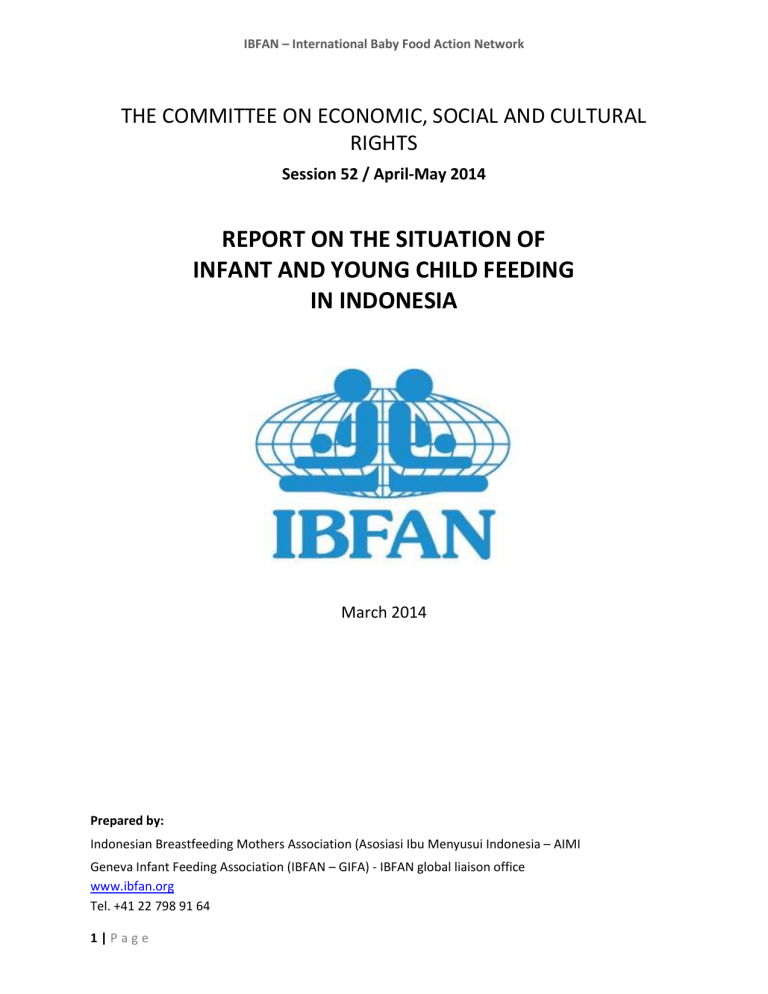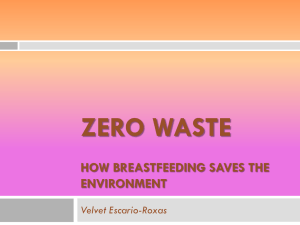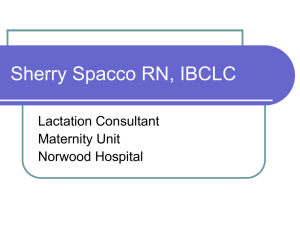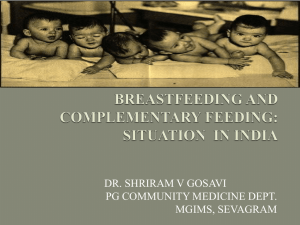int_cescr_css_idn_16930_e

IBFAN – International Baby Food Action Network
THE COMMITTEE ON ECONOMIC, SOCIAL AND CULTURAL
RIGHTS
Session 52 / April-May 2014
REPORT ON THE SITUATION OF
INFANT AND YOUNG CHILD FEEDING
IN INDONESIA
March 2014
Prepared by:
Indonesian Breastfeeding Mothers Association (Asosiasi Ibu Menyusui Indonesia – AIMI
Geneva Infant Feeding Association (IBFAN – GIFA) - IBFAN global liaison office www.ibfan.org
Tel. +41 22 798 91 64
1 | P a g e
IBFAN – International Baby Food Action Network
Breastfeeding: key to child and maternal health
The 1’000 days between a woman’s pregnancy and her child’s 2 nd birthday offer a unique window of opportunity to shape the health and wellbeing of the child. The scientific evidence is unambiguous: exclusive breastfeeding for 6 months followed by timely, adequate, safe and appropriate
complementary feeding practices, with continued breastfeeding for up to 2 years or beyond, provides the key building block for child survival, growth and healthy development 1 . This constitutes the infant and young child feeding practice recommended by the World Health Organisation (WHO) 2 .
Breastfeeding is key during this critical period and it is the single most effective intervention for saving lives. It has been estimated that optimal breastfeeding of children under two years of age has the potential to prevent 1.4 million deaths in children under five in the developing world annually 3 . In addition, it is estimated that 830.000 deaths could be avoided by initiating breastfeeding within one hour from birth 4 . Mother’s breastmilk protects the baby against illness by either providing direct protection against specific diseases or by stimulating and strengthening the development of the baby’s immature immune system. This protection results in better health, even years after breastfeeding has ended.
Breastfeeding is an essential part of women’s reproductive cycle: it is the third link after pregnancy and childbirth. It protects mothers' health, both in the short and long term, by, among others, aiding the mother’s recovery after birth, offering the mother protection from iron deficiency anaemia and is a natural method of child spacing (the Lactational Amenorrhea Method, LAM) for millions of women that do not have access to modern form of contraception.
Infant and young child feeding and human rights
Several international instruments make a strong case for protecting, promoting and supporting breastfeeding, and stipulate the right of every human being, man, woman and child, to optimal health, to the elimination of hunger and malnutrition, and to proper nutrition. These include the
International Covenant on Economic, Social and Cultural Rights (CESCR), especially article 12 on the
right to health, including sexual and reproductive health, article 11 on the right to food and articles
6, 7 and 10 on the right to work, the Convention on the Rights of the Child (CRC), especially article
24 on the child’s right to health, the Convention on the Elimination of All Forms of Discrimination
against Women (CEDAW), in particular articles 1 and 5 on gender discrimination on the basis of the
reproduction status (pregnancy and lactation), article 12 on women’s right to health and article 16
on marriage and family life. Adequately interpreted, these treaties support the claim that
‘breastfeeding is the right of every mother, and it is essential to fulfil every child’s right to adequate food and the highest attainable standard of health.’
As duty-bearers, States have the obligation to create a protective and enabling environment for women to breastfeed, through protecting, promoting and supporting breastfeeding.
1 IBFAN, What Scientific Research Says?, http://www.ibfan.org/issue-scientific-breastfeeding.html
2 WHO, 2002, Global Strategy on Infant and Young Child Feeding, http://www.who.int/nutrition/publications/infantfeeding/9241562218/en/index.html
3 UNICEF, http://www.childinfo.org/breastfeeding.html
4 Save the Children, 2012, Superfood for babies: how overcoming barriers to breastfeeding will save children’s lives. http://www.savethechildren.org/atf/cf/%7B9def2ebe-10ae-432c-9bd0df91d2eba74a%7D/SUPERFOOD%20FOR%20BABIES%20ASIA%20LOW%20RES%282%29.PDF
2 | P a g e
IBFAN – International Baby Food Action Network
The obstacles to optimal breastfeeding practices
Inadequate infant feeding practices co-exist with high rates of child mortality. The rate of early breastfeeding initiation is low (29.3%) and more than half of the children are not breastfeed until 6 months of age, while 35.6% of under-five children are stunted. For 43.9% of the children,
complementary food is introduced too early and 12.5% of the children of 4-5 months are weaned prematurely.
Absence of any policy or programme on infant and young child feeding.
Absence of sanctions in case of violations of the International Code of Marketing of Breastmilk
Substitutes.
Lack of data on Baby-friendly hospitals numbers and quality.
Absence of maternity protection for women working in the informal sector.
Lack of public awareness about HIV/AIDS and infant feeding.
Absence of emergency preparedness to ensure integrated response to protect and support breastfeeding in case of emergencies.
Our recommendations
We would like to propose these further recommendations for consideration by the CESCR Committee:
Adopt a national policy and a comprehensive programme on infant and young child feeding that include breastfeeding protection, promotion and support, and allocate sufficient resources to implement this policy and programme. Fully implement the International Code of Marketing of
Breastmilk Substitutes and its subsequent WHA resolutions as a minimal national standard, and ensure that such legislation is monitored on a regular basis and action is taken against those who violate the International Code through an effective sanction mechanism.
Raise awareness on optimal breastfeeding practices (early initiation, exclusive breastfeeding until
6 months, complementary breastfeeding until 2 years or more) through a wide national promotion campaign aimed at the public, especially parents and caregivers.
Allocate funds to implement the Baby-Friendly Hospital Initiative in all hospitals and maternity
facilities of the country and upgrade the curricula of health professionals to integrate accurate
training on optimal breastfeeding practices.
Ensure maternity protection for all working women, including those working in the informal sector, so that every Indonesian woman is protected during maternity and lactation.
Develop systematic collection and analysis of disaggregated data, including data on infant and young child feeding practices.
Raise awareness about HIV/AIDS and infant feeding through targeted promotion campaigns, especially in rural areas.
3 | P a g e
IBFAN – International Baby Food Action Network
1) General situation concerning breastfeeding in Indonesia
WHO recommends: 1) early initiation of breastfeeding (within an hour from birth); 2) exclusive
breastfeeding for the first 6 months; 3) continued breastfeeding for 2 years or beyond, together with adequate and safe complementary foods.
5
Despites these recommendations, globally more than half of the newborns are not breastfed within one hour from birth, less than 40% of infants under 6 months are exclusively breastfed and only a minority of women continue breastfeeding their children until the age of two.
Rates on infant and young child feeding:
Early initiation: Proportion of children born in the last 24 months who were put to the breast within one hour of birth
Exclusive breastfeeding: Proportion of infants 0–5 months of age who are fed exclusively with breast milk
Continued breastfeeding at 2 years: Proportion of children 20–23 months of age who are fed breast milk
Complementary feeding: Proportion of infants 6–8 months of age who receive solid, semi-solid or soft foods
General data
Annual number of birth
Neonatal mortality rate (per 1000 live births)
Infant mortality rate (per 1000 live births)
Infant – under 5 – mortality rate (per 1000 live births)
Maternal mortality ratio (per 100,000 live births)
(adjusted)
Delivery care coverage (%):
Skilled attendant at birth
Institutional delivery
Stunting (under 5 years)
2008-2012 6 2011 7
37
220 (2010) 228
83.1
63.2
35.6%
2012 8
4,736,000
15
26
31
5 http://www.who.int/topics/breastfeeding/en/
6 UNICEF, Indonesia Statistics, available at: http://www.unicef.org/infobycountry/indonesia_statistics.html
7
UNICEF Inondesia, Ringkasan Kajian, Kesehatan Ibu & Anak, 2012, available at: http://www.unicef.org/indonesia/id/A5_-_B_Ringkasan_Kajian_Kesehatan_REV.pdf
8 UNICEF, Indonesia Statistics, available at: http://www.unicef.org/infobycountry/indonesia_statistics.html
4 | P a g e
IBFAN – International Baby Food Action Network
Breastfeeding data
2008-2012 9
Early initiation of breastfeeding (within one hour from birth)
Children exclusively breastfed (0-5 months)
Introduced to solid food (6-8 months)
29.3%
41.5%
84.6%
Breastfeeding at age 2 55.3%
The main causes of infants and children mortality are infections such as pneumonia and diarrhoea.
More than one child under 5 out of three is stunted, which represents a great portion. The delivery
care coverage in is low: almost one woman out of five is not assisted by a skilled attendant during delivery, and more than one woman out of three does not give birth in a medical institution. In addition, early breastfeeding initi ation, skin to skin contact between the baby and the mother and also rooming-in seem not to be promoted at all in some of the health facilities.
According to the Demographic Health Survey 10 , there are almost no differences between rural and urban areas concerning breastfeeding practices.
The table above provides a presentation of the overall feeding patterns among children 0-23 months for
2012, in Indonesia. It shows that only half of the children under one month are exclusively breastfed.
The table also indicates that one child under one month out of three is already consuming infant
9 UNICEF, Indonesia Statistics, available at: http://www.unicef.org/infobycountry/indonesia_statistics.html
10 DHS and Ministry of Health, Indonesia Demographic and Health Survey, 2012, available at: http://dhsprogram.com/pubs/pdf/FR275/FR275.pdf
5 | P a g e
IBFAN – International Baby Food Action Network
formulas and other milk than breastmilk. This is problematic because, according to the WHO recommendations, infants should be exclusively breastfed until the age of 6 months. Besides, the table shows that a large portion of children between 2 to 3 months are being fed with complementary food and this rate considerably increases between 4 to 8 months, indicating that complementary food is
introduced earlier than the recommended 6-9 months. In addition, already 12.5% of the children between 4 to 5 months are being prematurely weaned. This rate increases and reaches a peak of 40.3% of children being weaned between 18 and 23 months, while ideally, weaning should start at 22-23 months
2) International Code of Marketing of Breastmilk Substitutes
Evidence clearly shows that a great majority of mothers can breastfeed and will do so if they have the accurate and full information and support, as called for by the Convention on the Rights of the Child.
However, direct industry influence through advertisements, information packs and contact with sales representatives, as well as indirect influence through the public health system, submerge mothers with
incorrect, partial and biased information.
The International Code of Marketing of Breastmilk Substitutes (the International Code) has been adopted by the World Health Assembly in 1981. It is a minimum global standard aiming to protect appropriate infant and young child feeding by requiring States to regulate the marketing activities of enterprises producing and distributing breastmilk substitutes in order to avoid misinformation and undue pressure on parents to use such products when not strictly necessary. Even if many countries have adopted at least some provisions of the International Code in national legislation, the implementation and enforcement are suboptimal, and violations persist.
Indonesia has adopted many of the provisions of the International Code of Marketing of Breastmilk
Substitutes through the ministerial decree No 237/MENKES/SK/IV/1997. However, the decree does not provide any sanctions in case of violations. Besides, the implementation and monitoring of this law on the regulations of marketing of breastmilk substitutes was postponed due to conflicts of interest.
3) Baby-Friendly Hospital Initiative (BFHI) and training of health workers
Lack of support to breastfeeding by the health care system and its health care professionals further increase difficulties in adopting optimal breastfeeding practices.
The Baby-Friendly Hospital Initiative (BFHI), which consists in the implementation by hospitals of the
‘Ten steps for successful breastfeeding’, is a key initiative to ensure breastfeeding support within the health care system. However, as UNICEF support to this initiative has diminished in many countries, the
implementation of BFHI has significantly slowed down. Revitalization of BFHI and expanding the
Initiative’s application to include maternity, neonatal and child health services and community-based support for lactating women and caregivers of young children represents an appropriate action to address the challenge of adequate support.
The Ministry of Health in Indonesia has a program called “Mother and Baby Friendly Hospital Initiative”
6 | P a g e
IBFAN – International Baby Food Action Network which is totally different from BFHI. The Indonesian initiative rewards health facilities that refuse to collaborate with the baby food industry.
However, it is still common that hospitals work in close collaboration and cooperation with formula industry and violate the International Code by giving free formula samples to mothers, organizing sponsored seminars and events for doctors and other health workers and providing the free sponsored medical supplies.
Actually, there is no specific programme to promote BFHI in Indonesia. In addition, there is no up-todate information on the number and quality of the baby-friendly hospitals and health facilities in the country. The latest data, issued in 2012 11 , indicates that out of a total of 1,971 hospitals and maternity facilities, 91 have ever been designated as “baby-friendly”. We invite the CRC Committee to request more information on the state of implementation of the BFHI in the country.
4) Maternity protection for working women
The main reason given by majority of working mothers for ceasing breastfeeding is their return to work
following maternity leave.
It is therefore necessary to make adjustments in the workload of mothers of young children so that they may find the time and energy to breastfeed; this should not be considered the mother’s responsibility, but rather a collective responsibility. Therefore, States should adopt and monitor an adequate policy of maternity protection in line with ILO Convention 183 (2000) 12 that facilitate six months of exclusive breastfeeding for women employed in all sectors, and facilitate workplace accommodations to feed and/or to express breastmilk.
Proportion of working women: 38.58%
13
Maternity leave
The labour code (Law No 13/2003) states that maternity leave applies to women employed in the formal sector. Women working in the informal sector are not covered by this maternity social insurance.
Duration: The duration of maternity leave is a period of 3 months, with the possibility of extension if required for medical reasons. 14
Conditions: Working women are entitled to a 1.5 (one-and-a-half) month period of rest before the time
11 Labbok M. H., 2012, “Global Baby-Friendly Hospital Initiative Monitoring Data: Update and Discussion”,
Breastfeeding medicine, 7 (4):210-222. Available at: https://www.google.ch/url?sa=t&rct=j&q=&esrc=s&source=web&cd=1&cad=rja&uact=8&ved=0CC4QFjAA&url=htt p%3A%2F%2Fwww.researchgate.net%2Fpublication%2F230617756_Global_babyfriendly_hospital_initiative_monitoring_data_update_and_discussion%2Ffile%2F79e415037abf6c5f21.pdf&ei=HGk pU4m0B8WGywPPtoH4Bg&usg=AFQjCNGp83uM79JmdQTYHnM5_V0I14kqGQ&bvm=bv.62922401,d.bGQ
12 ILO, C183 - Maternity Protection Convention, 2000 (No. 183)
13 Kementerian Tenaga Kerja dan Tranmigrasi, Rencana Pembangunan Jangka Panjang 2010-2025, 2012. Available at : http://www.depnakertrans.go.id/uploads/doc/RPJP.pdf
14 ILO, Maternity Protection, Indonesia, 2011. Available at: http://www.ilo.org/dyn/travail/travmain.sectionReport1?p_lang=en&p_countries=ID&p_sc_id=2000&p_year=201
1&p_structure=3
7 | P a g e
IBFAN – International Baby Food Action Network at which they are estimated by an obstetrician or a midwife to give birth to a baby and another 1.5 (oneand-a-half) month period of rest thereafter.
Breastfeeding breaks: The new law no 33/3012 states that breastfeeding breaks can be taken 2 to 3 times a day and are paid by the employer. The employer also needs to provide other facilities like nursing room for the working women that would require it.
Last year, the Indonesian Breastfeeding Mothers Association (AIMI) has issued a guideline document in collaboration with ILO and Better Work Indonesia explaining to employers how to provide maternity benefits to their workers 15 .
5) HIV and infant feeding
The HIV virus can be passed from mother to the infant though pregnancy, delivery and breastfeeding.
The 2010 WHO Guidelines on HIV and infant feeding 16 call on national authorities to recommend, based on the AFASS17 assessment of their national situation, either breastfeeding while providing antiretroviral
medicines (ARVs) or avoidance of all breastfeeding. The Guidelines explain that these new recommendations do not remove a mother’s right to decide regarding infant feeding and are fully consistent with respecting individual human rights.
Prevalence of HIV/AIDS amongst people between 15 and 49 is of 0.4%, which represents 610,000 persons in the country.
18
According to the Demographic Health Survey 19 , people living in rural areas are less aware of safe
HIV/AIDS prevention methods (33.5%) than in urban areas (51.5%). However, the knowledge rate of
HIV/AIDS infection is relatively low. Only one woman out of two knows about HIV infections. The main cause of infections is sexual intercourse between a HIV-positive and an HIV-negative partner. HIV prevention programmes insist on three aspects to prevent the infection: on the importance to have a limited number of sexual partners, to use condoms and to delay sexual debut for young persons.
Women and men are almost equally aware about the risk of transmitting the infection to the child during pregnancy, delivery and breastfeeding (between 62-65.9%). Around 84.1% of HIV-positive people received antiretroviral treatment in 2011 20 .
15 Asosiasi Ibu Menyusui Indonesia (AIMI). Available at: http://aimi-asi.org/ilo-bwi-aimi-campaign/
16 2010 WHO Guidelines on HIV and infant feeding: http://whqlibdoc.who.int/publications/2010/9789241599535_eng.pdf
17 Affordable, feasible, acceptable, sustainable and safe (AFASS)
18 UNAIDS, Indonesia, available at: http://www.unaids.org/en/regionscountries/countries/indonesia/
19 DHS and Ministry of Health, Indonesia Demographic and Health Survey, 2012. Available at: http://dhsprogram.com/pubs/pdf/FR275/FR275.pdf
20 Public Citizen, Antiretroviral Treatment in Indonesia, available at: http://www.citizen.org/treatment-in-Indonesia
8 | P a g e
IBFAN – International Baby Food Action Network
6) Government measures to protect and promote and support breastfeeding
Adopted in 2002, the Global Strategy for Infant and Young Child Feeding defines 9 operational targets:
1.
Appoint a national breastfeeding coordinator with appropriate authority, and establish a multisectoral national breastfeeding committee composed of representatives from relevant government departments, non-governmental organisations, and health professional associations.
2.
Ensure that every facility providing maternity services fully practises all the “Ten steps to successful
breastfeeding” set out in the WHO/UNICEF statement on breastfeeding and maternity services.
3.
Give effect to the principles and aim of the International Code of Marketing of Breastmilk
Substitutes and subsequent relevant Health Assembly resolutions in their entirety.
4.
Enact imaginative legislation protecting the breastfeeding rights of working women and establish means for its enforcement.
5.
Develop, implement, monitor and evaluate a comprehensive policy on infant and young child
feeding, in the context of national policies and programmes for nutrition, child and reproductive health, and poverty reduction.
6.
Ensure that the health and other relevant sectors protect, promote and support exclusive breastfeeding for six months and continued breastfeeding up to two years of age or beyond, while providing women access to the support they require – in the family, community and workplace – to achieve this goal.
7.
Promote timely, adequate, safe and appropriate complementary feeding with continued
breastfeeding.
8.
Provide guidance on feeding infants and young children in exceptionally difficult circumstances, and on the related support required by mothers, families and other caregivers.
9.
Consider what new legislation or other suitable measures may be required, as part of a comprehensive policy on infant and young child feeding, to give effect to the principles and aim of the
International Code of Marketing of Breastmilk Substitutes and to subsequent relevant Health Assembly resolutions.
National measures
Indonesia has not implemented any national policy on infant and child feeding. Its overall national action plans concerning child feeding are poor. This is due to an inadequate human resources capacity and competency and to the insufficient budget allocation.
Monitoring of national measures
There is a coordination programme focusing on infant and child nutrition and health. However, the programme is not monitored by the government itself but by NGOs such as Mothers’ and Children’
Health Movement (Gerakan Kesehatan Ibu dan Anak – GKIA), which regularly meets with other NGOs, discusses on the recent issues and collects data in case of violations.
The Indonesian Breastfeeding Mothers Association (Asosiasi Ibu Menyusui Indonesia – AIMI) has a call centre to report violations of the Code. The association Badan Kerja Peningkatan Penggunaan Air Susu
Ibu (BKPP-ASI) also collaborates with IBFAN in this regard.
9 | P a g e
IBFAN – International Baby Food Action Network
Scaling Up Nutrition (SUN) initiative
Indonesia has become a member of the Scaling Up Nutrition (SUN) initiative, whose aim is to promote the right to food and good nutrition. However, its actions are controversial because behind the claim of addressing malnutrition, the also initiative also strives to facilitate the opening up of markets for its 600 partners companies (among others, Danone, Pepsico, Coca Cola and Brittania).
21
7) Recommendations on breastfeeding by the CRC Committee
The Convention on the Rights of the Child has placed breastfeeding high on the human rights agenda.
Article 24 mentions specifically the importance of breastfeeding as part of the child’s right to the
highest attainable standard of health.
Issues like the improvement of breastfeeding and complementary feeding practices, the right to adequate information for mothers and parents, the protection of parents against aggressive marketing of breastmilk substitute products through the implementation of and compliance with the International
Code of Marketing of Breastmilk Substitutes as well as the need for strong and universal maternity protection are now systematically discussed during State parties reviews by the CRC Committee.
At the last review in January 2004, the CRC Committee made the following recommendations in its
Concluding Observations to Indonesia (CRC/C/IDN/CO/2 22 ) (emphasis added):
57. The Committee recommends that the State party: (a) Ensure universal access to primary health care, especially maternal and child health-care services and facilities, including in rural and conflict-affected areas; (b) Prioritize the provision of drinking water and sanitation services; (c) Strengthen existing efforts to prevent malnutrition, malaria and other mosquitoborne diseases, to immunize as many children and mothers as possible, to make condoms and other contraceptives available throughout the country and to promote breastfeeding, and extend these programmes to all conflict-affected areas; (d) Ensure that a life-course approach is taken with respect to child and adolescent health and development through the development of holistic and comprehensive health policies for children and adolescents; (e) Seek
cooperation in this matter from, among others, WHO.
21 Schuftan C. and Greiner T., 2013, “The Scaling Up Nutrition (SUN) Initiative”, in: Right to Food and Nutrition
WATCH: Alternatives and Resistance to Policies that Generate Hunger. Available at : http://scalingupnutrition.org/wpcontent/uploads/2013/10/Right_Food_Nutrtion_Watch_SUN_2013_eng_WEB_final.pdf
22 http://tbinternet.ohchr.org/_layouts/treatybodyexternal/Download.aspx?symbolno=CRC%2fC%2f15%2fAdd.223&
Lang=en
10 | P a g e
IBFAN – International Baby Food Action Network
About the International Baby Food Action Network (IBFAN)
IBFAN is a 35-year old coalition of more than 250 not-for-profit non-governmental organizations in more than
160 developing and industrialized nations. The network works for better child health and nutrition through the protection, promotion and support of breastfeeding and the elimination of irresponsible marketing of breastmilk substitutes.
IBFAN is committed to the Global Strategy on Infant and Young Child Feeding (2002), and thus to assisting governments in implementation of the International Code of Marketing of Breastmilk Substitutes and its relevant resolutions of the World Health Assembly (WHA) to the fullest extent, and to ensuring that corporations are held accountable for International Code violations. In 1998, IBFAN received the Right Livelihood Award “for its committed and effective campaigning for the rights of mothers to choose to breastfeed their babies, in the full knowledge of the health benefits of breastmilk, and free from commercial pressure and misinformation with
which companies promote breastmilk substitutes”.
11 | P a g e



